Engaging Fairy Tale Activities for Preschoolers
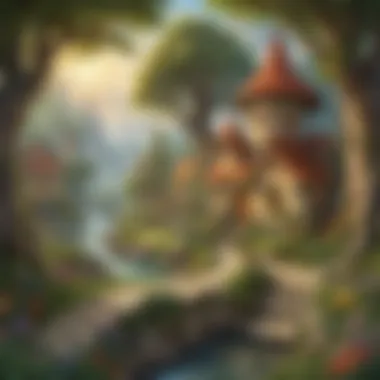
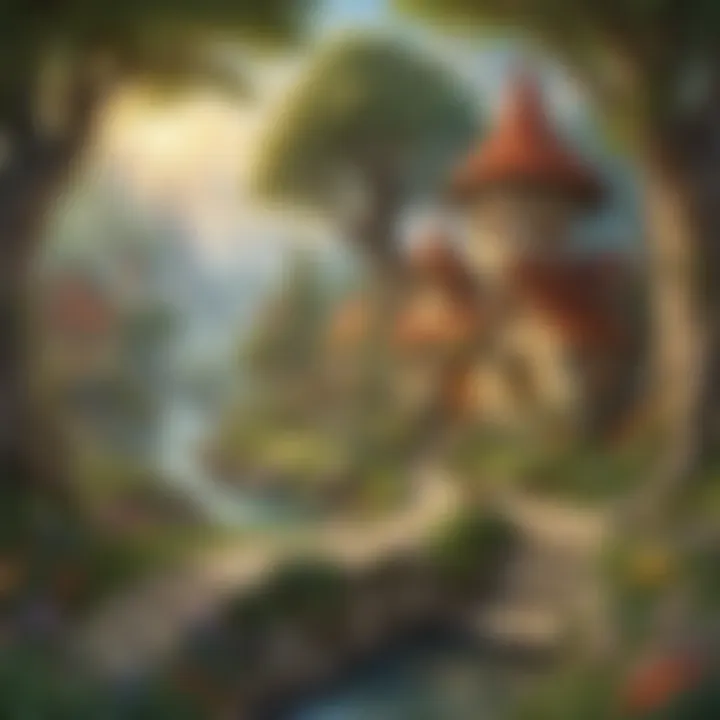
Intro
Engaging preschoolers in imaginative play is crucial for their development. Fairy tales offer a unique platform for this type of learning. They stimulate creativity, foster social interactions, and encourage critical thinking. By integrating fairy tale activities into education, parents and educators can create a rich, interactive environment.
This article presents a range of fairy tale activities tailored for young children. We will explore creative crafts, storytelling practices, and other hands-on experiences. All of these ideas are designed to inspire children while enhancing their learning.
Engaging children through storytelling not only entertains but also lays the groundwork for vital skills.
Creative Activities
Crafting provides a fun avenue for preschoolers to express their creativity. Here are some engaging craft ideas inspired by popular fairy tales:
Craft Ideas
- Crown Making: Children can create their own crowns using colored paper, stickers, and glitter. This activity aligns perfectly with tales involving royalty.
- Character Puppets: Using socks or paper bags, kids can design their favorite fairy tale characters. This encourages role play.
- Story Stones: Smooth stones can be painted to represent various story elements or characters, enabling children to retell stories in their unique way.
Step-by-Step Guides
- Making a Paper Crown: 1. Cut a strip of paper for the base. 2. Decorate with markers and stickers. 3. Staple ends together to fit on the head. 4. Wear it proudly!
- Creating Puppets: 1. Decide on a character. 2. Use glue to attach eyes, mouth, and decorations. 3. Once dry, engage in puppet shows!
Educational Value
These activities nurture fine motor skills and enhance their ability to follow directions. Furthermore, they promote storytelling, as children learn to narrate their creations.
"Creative activities are pivotal in solidifying children’s understanding of stories and characters."
By participating in hands-on activities, children not only have fun but also gain confidence and learn to collaborate with peers. Through imaginative play, they develop empathy by putting themselves in the characters’ shoes.
Fun Quizzes
Engaging quizzes are another effective educational tool. They reinforce learning while keeping the content enjoyable.
Quiz Topics
Quizzes can cover various aspects of fairy tales:
- Character Identification: Recognizing characters from different stories.
- Plot Points: Understanding key events within the tales.
- Moral Lessons: Discussing the lessons taught by each story.
Question Types
The quizzes can incorporate various question types:
- Multiple Choice: Ideal for simple recognition.
- True/False: A quick way to test comprehension.
- Fill in the Blanks: Encourages recall of specific details.
Knowledge Reinforcement
These quizzes help reinforce what children have learned through storytelling and crafts. They support memory retention and boost confidence as children answer questions correctly.
Fact-Based Articles
In conjunction with activities and quizzes, fact-based articles can add depth to the learning process.
Topics
- Origins of Fairy Tales: Understanding where these stories came from.
- Cultural Variations: Learning how fairy tales differ across cultures.
- Famous Authors: Exploring creators like Hans Christian Andersen and the Brothers Grimm.
Engaging Content
These articles present facts in a child-friendly manner. Using simple language ensures that young readers can grasp the material easily.
Prelims to Fairy Tale Activities
Fairy tale activities are essential in early childhood education because they tap into the rich narratives that capture children's imaginations. Through these activities, educators and caregivers can create learning environments that stimulate creativity and critical thinking. They help preschoolers connect with stories that have been well-loved over generations.
The importance of these activities extends beyond simple enjoyment. They serve as a foundation for many educational concepts. By engaging with fairy tales, children learn narrative skills, such as sequencing and comprehension. These tales also introduce children to varied character traits and moral lessons, enriching their emotional understanding and social skills.
Fairy tales provide an interractive backdrop that encourages exploration and experimentation. Children can take on different characters, creating a playful and immersive experience. This is quite similar to a playground for the mind, where learning feels effortless and fun. Moreover, these activities can bridge cultural gaps through shared stories, promoting inclusiveness and understanding.
The Role of Fairy Tales in Early Childhood Development
Fairy tales play a crucial role in early childhood development. They are more than mere stories; they provide a structured way for children to understand social norms and morals. Characters often face challenges that require thoughtful decisions, which mirrors real-life situations. As preschoolers relate to these characters, they start to develop empathy and problem-solving skills.
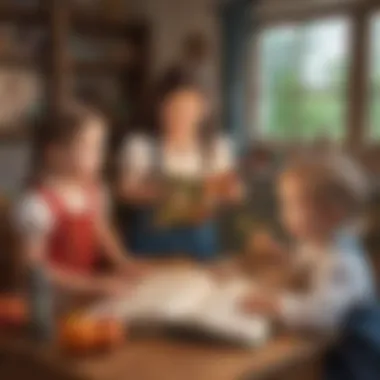
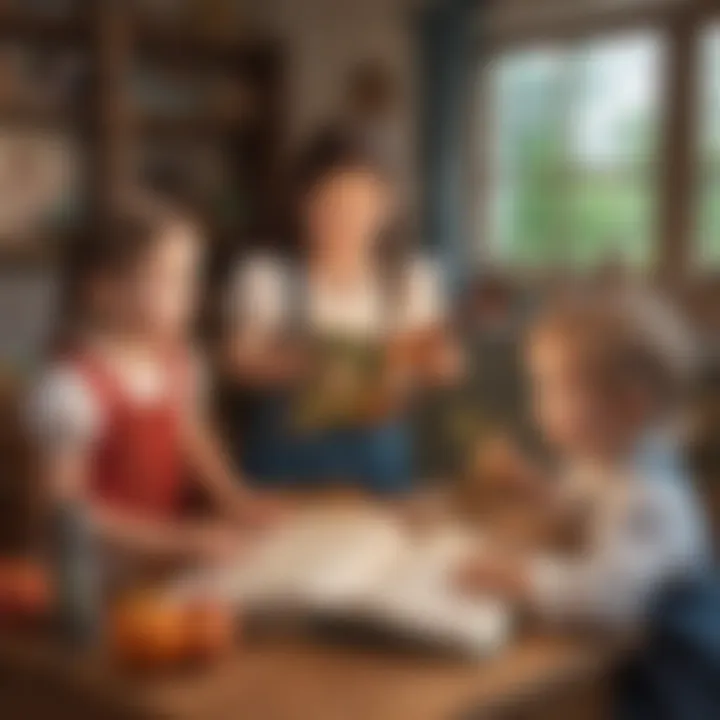
The repetition of fairy tale themes can help solidify understanding in young minds. The clear narratives help children learn cause and effect as they see consequences unfold in the stories. Additionally, these tales often contain whimsical elements—like talking animals or magical events—which ignite imagination and promote creativity. This imagination can be the catalyst for inventive thinking down the line.
Benefits of Engaging with Fairy Tales
Engaging preschoolers with fairy tales offers a range of benefits, especially in language and literacy development. By hearing stories read aloud, children enhance their vocabulary and storytelling abilities. It also encourages listening skills, as they must pay attention to follow the narrative.
Furthermore, fairy tales often are structured with repetition and rhyme, making them easier for children to remember and retell. This pattern helps reinforce language acquisition and improves memory.
In addition to language skills, these stories provide emotional benefits. Children can express their feelings through the lens of characters. This distancing can make it easier for them to tackle complex feelings and social situations. Thus, engaging with fairy tales can be a gentle introduction to conversations about emotions and ethics.
"Fairy tales are not just entertainment; they are learning tools that resonate deeply with children's development."
Overall, the presentation of fairy tales as activities in preschool settings helps lay the groundwork for holistic development in children. This enriched framework promotes a love for learning while integrating critical social skills.
Storytelling Techniques for Preschoolers
Storytelling is a vital component in the early education of preschoolers. It captivates their attention and enriches their cognitive development. Techniques in storytelling can make reading more interactive and enjoyable. These practices are not only beneficial for language development, but they also stimulate imagination and emotional growth. It’s essential to recognize how storytelling can create a bridge between literature and life experiences for young children. Engaging them through stories lays the groundwork for critical thinking and social skills, which are fundamental for their overall development.
Interactive Storytelling Practices
Making storytelling interactive is key in holding the attention of preschoolers. This means involving children actively in the narrative. Here are some effective approaches:
- Encourage participation: Ask children to predict what will happen next. This sparks their thinking skills and makes them feel part of the story.
- Character voices: Use different voices for different characters. This adds fun and enables children to connect more with the characters.
- Choral reading: Reading parts of the story together can engage younger learners. It gives them confidence and an opportunity to practice their reading skills in a group setting.
Interactive storytelling practices enable children to become more than just listeners. They become participants, which enhances their emotional connection to the tales.
Using Props to Enhance Engagement
Props are essential tools in storytelling. They can turn a simple narrative into an immersive experience. The following are ways to integrate props effectively:
- Visual aids: Display illustrations or objects related to the story. For example, if telling a tale about Goldilocks, use bear puppets or bowls to represent porridge.
- Costumes: Dressing up can bring the story to life. Children can wear simple costumes that represent characters, making them feel more involved.
- Physical items: Use items that appeal to the senses. Soft toys or textures can represent parts of the story, encouraging children to touch and feel as the story unfolds.
Using props invites curiosity and is especially effective in maintaining focus. It transforms storytelling into an enjoyable learning adventure, making the experience memorable for preschoolers.
Craft Activities Inspired by Fairy Tales
Craft activities are crucial in early learning as they merge creativity with fundamental skills. Engaging in crafts based on fairy tales encourages children to express their imagination while developing hand-eye coordination and fine motor skills. This section delves into two primary aspects of crafting: creating characters and building environments from recyclable materials. Each activity offers a rich opportunity for children to connect more deeply with narratives and enhances their understanding of storytelling.
Creating Characters with Simple Materials
Creating characters from fairy tales can be an exciting way for preschoolers to interact with their favorite stories. Using simple materials such as paper, cardboard, and fabric, children can design figures representing characters like Little Red Riding Hood or the Big Bad Wolf. The process not only stimulates creativity but also fosters critical thinking.
Using materials that are easy to manipulate, preschoolers can explore textures, shapes, and colors as they craft their characters. This activity helps to:
- Foster Imagination: Children can invent stories through their characters.
- Enhance Communication: Discussing their creations improves language skills.
- Encourage Individuality: Each child’s character will be unique, reflecting their personal style and ideas.
To create characters, one can follow these simple steps:
- Gather Materials: Collect items like paper plates for heads, colored paper for costumes, or fabric scrapes.
- Design: Encourage children to think about what makes each character special and how they want to depict them.
- Assemble: Let children glue and tape various components together, offering guidance as needed but also allowing for independence.
Building Fairy Tale Settings with Recyclable Items
Building fairy tale settings introduces preschoolers to concepts of space and environment. Using recyclable items like cardboard boxes and plastic bottles opens doors for creativity and sustainability. Children can create settings like enchanted forests or castles just by using materials readily available at home. This activity enhances sensory experiences as well, giving depth to the stories they hear.
Here are some benefits of crafting settings:
- Promotes Collaborative Play: Children can work together to create a larger setting, learning to share ideas.
- Encourages Problem-Solving Skills: They must figure out how to use various materials to represent different story elements.
- Supports Environmental Awareness: Using recyclables teaches the importance of sustainability early on.
To build a fairy tale landscape:
- Collection: Gather a variety of recyclable items and set them out for exploration.
- Planning: Discuss what setting they want to create and how to represent it.
- Construction: Allow children to assemble their scenes with guidance, encouraging problem-solving and teamwork.
"Crafts are a hands-on way for young learners to engage with stories in dynamic ways."
Craft activities inspired by fairy tales are not just about making things; they are about connecting ideas, fostering creativity, and building a bridge between stories and real-world experiences. Through such activities, children learn while having fun, developing skills that benefit their overall growth.
Dramatic Play and Role-Playing Activities
Dramatic play and role-playing activities hold a significant place in the context of preschool education. These activities allow children to immerse themselves in imaginative scenarios, fostering not just creativity but also essential social skills. When preschoolers engage in dramatic play, they explore different perspectives, which enhances empathy and emotional understanding. This form of play is instrumental in language development as children practice new vocabulary in context and construct narratives as they assume various character roles.
Role-playing also encourages critical thinking and problem-solving. By navigating through fairy tale scenarios, children learn to collaborate with peers, negotiate roles, and resolve conflicts that arise during play. This active engagement supports cognitive growth, making dramatic play essential for a well-rounded educational experience.
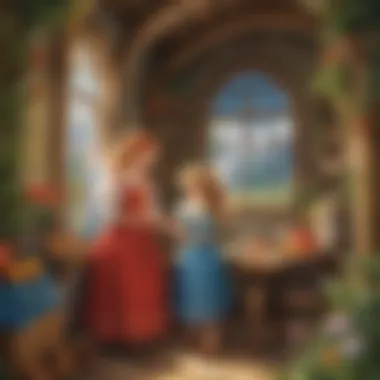
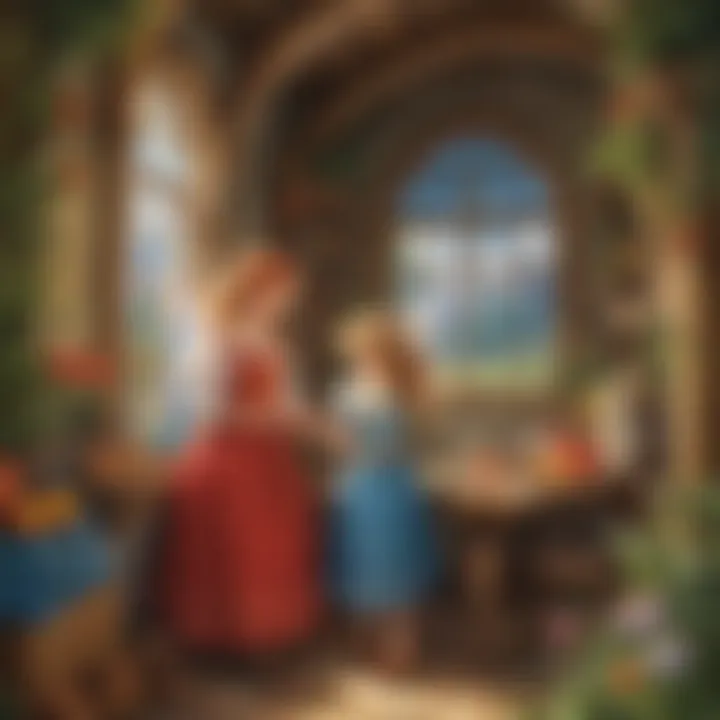
An important consideration is the environment where these activities take place. A space that is safe and inviting, equipped with various props and costumes related to fairy tales, can stimulate children's interest and motivate them to participate.
Setting Up a Fairy Tale Theater
Creating a fairy tale theater allows children to bring stories to life through performance. To set up a fairy tale theater, educators and caregivers can follow these steps:
- Designate a Space: Choose an area where children can act freely. It could be a corner of a room or an outdoor area. Ensure the space is spacious enough to accommodate small groups.
- Gather Materials: Collect costumes, hats, masks, and props related to well-known fairy tales. Items like capes, crowns, or even simple cardboard cutouts can enhance the experience. Having puppets can add another layer of creativity.
- Select Stories: Choose a variety of fairy tales that children are familiar with or introduce new ones. Stories like "Goldilocks and the Three Bears" or "Jack and the Beanstalk" are excellent starting points.
- Encourage Imaginative Scripts: Allow children to retell the story in their own words. Encourage them to create dialogues or even alter the plot. This promotes language use and creativity.
- Promote Performance: Arrange for a small audience of peers or caregivers to watch the performances. This experience can help children become comfortable with public speaking and boost their confidence.
Encouraging Cooperative Play through Character Roles
Another essential aspect of dramatic play is encouraging cooperative play by assigning character roles. When children take on the roles of different characters within a fairy tale, they learn to work together towards a shared narrative. This cooperation is beneficial in various ways:
- Social Skills Development: By discussing which roles to assume, children practice taking turns and considering others' ideas. This collaborative effort strengthens their ability to communicate effectively with peers.
- Problem-Solving Opportunities: As the story unfolds, conflicts may arise that the characters must navigate. Working together to find solutions fosters teamwork.
- Role Flexibility: Encourage children to switch roles during play. This flexibility helps them appreciate different viewpoints and enhances their adaptability.
Integrating roles from diverse fairy tales can enrich the experience. For instance, adding lesser-known characters from various cultural stories broadens children's understanding of narratives while promoting inclusivity.
Overall, dramatic play and role-playing activities serve as powerful tools in preschool education, nurturing essential life skills through engaging and imaginative methods.
Sensory Activities Related to Fairy Tales
Engaging preschoolers through sensory activities related to fairy tales fosters not only their imagination but also their cognitive development. Young minds absorb information and learn best when they can explore through tactile experiences. Sensory play encourages curiosity and allows children to connect with stories on a deeper level. By using fairy tales as a framework, sensory activities can be woven into the narrative structure, making learning vibrant and interactive. This article section explores two specific sensory activities: creating sensory bins with themed materials and exploring various textures through items related to well-known stories.
Creating Sensory Bins with Fairy Tale Themes
Sensory bins provide a hands-on environment where children can engage with stories in a concrete way. A fairy tale-themed sensory bin can include various elements that correlate with a specific story. For instance, a bin inspired by "Goldilocks and the Three Bears" might contain oats, small bear figurines, porridge containers, and a doll representing Goldilocks. This setup encourages children to recount the story while manipulating the materials.
Key considerations when creating sensory bins include:
- Safety: Ensure all materials used are age-appropriate and non-toxic. Avoid small items that may pose choking hazards.
- Variety of textures: Incorporate different textures to stimulate the sense of touch. For example, use soft fabrics, rough tree bark, and smooth stones.
- Multisensory elements: Adding scents like cinnamon or vanilla can enhance the experience. Create a "Little Red Riding Hood" sentiment using fabric for the cape and adding a basket with fake fruits.
- Reusability: Select materials that can be reused for different themes. This keeps costs manageable and allows for creativity.
By focusing on thematic storytelling, children can articulate their own imaginative tales while they play, enhancing verbal skills.
Exploring Textures through Story-Related Items
The act of exploring textures through story-related items serves as a bridge between the narrative and the sensory world. This can include fabrics, natural materials, and common household items that reflect elements found within fairy tales.
For example, in a classroom lined with books, a story about "Jack and the Beanstalk" can be paired with real beans of different shapes and sizes. Children can feel the smoothness of the beans and the rough surface of the soil, making the story tactile.
Benefits of this activity include:
- Enhanced sensory awareness: As children feel and compare different textures, they develop better sensory processing skills.
- Rich vocabulary development: Discussing textures using descriptive language improves linguistic abilities. Children can learn terms like rough, smooth, slimy, or soft.
- Connection to the narrative: Relating textures back to key story elements deepens comprehension and retention. This linkage makes the stories more memorable and impactful.
Utilizing sensory experiences in fairy tale contexts provides opportunities for rich, multi-dimensional learning, fostering both cognitive and emotional development as children celebrate creativity in their play.
Sensory play not only supports children's growth and development but also ties them closer to the narratives they explore.
Literacy Activities through Fairy Tales
Engaging preschoolers in literacy activities through fairy tales is vital for their development. This approach encourages early reading skills, comprehension, and vocabulary. Fairy tales are not just stories; they are gateways to language learning. Familiar narratives help children predict story outcomes and enhance their understanding of sequencing. Furthermore, these activities can be tailored to their interests, which fosters a love for reading.
Using fairy tales for literacy builds critical thinking. Kids learn to analyze character motivations and plot structures, which develops stronger cognitive skills. Parents and educators should consider integrating various forms of storytelling to enrich the experience.
Story Sequencing with Picture Cards
Story sequencing using picture cards is an effective way to reinforce understanding of narrative order. It encourages children to think about the beginning, middle, and end of a story. Picture cards can be sourced from the fairy tales they are familiar with. For example, cards depicting scenes from "Goldilocks and the Three Bears" can guide kids through retelling the story in their own words.
- Selecting a Fairy Tale: Choose a familiar story that has clear events.
- Creating Picture Cards: Use images that represent key scenes. Take simple drawings or cut out images from magazines that represent the narrative moments.
- Activity Steps:
- Shuffle the cards and ask children to arrange them in the correct order.
- Discuss why they placed each card where they did. This conversation deepens comprehension and fosters language skills.
Benefits: Engaging in this activity strengthens narrative skills, enhances listening abilities, and boosts memory retention.
Creating Personalized Fairy Tales
Creating personalized fairy tales extends the excitement and learning possibilities beyond traditional stories. This activity allows children to become the authors of their own narratives. It cultivates creativity and original thinking.
- Starting with a Template: Provide children with a simple template. A basic structure might include a character, a setting, a problem, and a solution.
- Guiding Questions: Ask questions that stimulate imagination. What if the main character was a dragon? Where do they live? How do they solve their problems?
- Story Creation:
- Have the children illustrate their stories. Using crayons or digital apps can engage their artistic side.
- Encourage them to share their tales with family or friends, promoting oral language skills.
Benefits: This activity not only enhances literacy through writing but also instills confidence in their storytelling abilities. Kids learn that their thoughts and ideas are meaningful and worthy of expression.
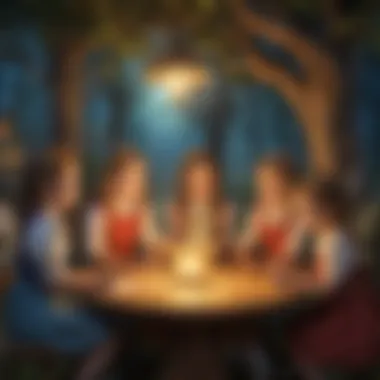
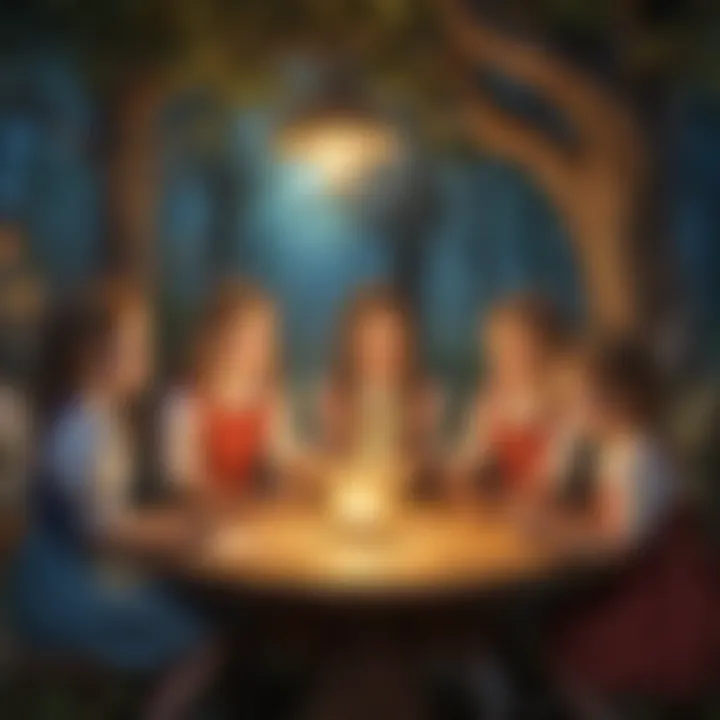
Imagination is the foundation for literacy. By creating their own stories, preschoolers enhance both imagination and language skills.
Mathematics Activities Inspired by Fairy Tales
Incorporating mathematics into fairy tale activities can significantly enhance preschoolers' understanding of numbers and problem-solving in a fun way. Using familiar stories, educators and parents can create engaging learning experiences that help children develop a solid foundation in math. By aligning math concepts with beloved fairy tales, children can relate better to the activities, and it makes learning more enjoyable.
Through counting and measurement, kids not only practice their math skills but also gain a deeper comprehension of the stories themselves. The emphasis on connection between math and storytelling encourages critical thinking and nurtures curiosity in young learners.
Counting Activities Using Fairy Tale Objects
Counting is one of the essential skills in early mathematics. Engaging with fairy tale characters or items allows children to practice counting in a context that is meaningful and relatable. For example, in the story of Goldilocks and the Three Bears, children can count the three bowls of porridge, three chairs, and three beds.
Here are some activities that can enhance counting skills:
- Create a Goldilocks scene: Use small toys or paper cutouts to represent Goldilocks and the bears. Ask children to count each item in the scene.
- Counting the Three Little Pigs: Provide children with building blocks. As they build houses for each pig, they can count how many blocks they use for each house.
- Jack and the Beanstalk: Kids can count the beans or any small objects that represent the beanstalk's growth. They can even draw or color in a beanstalk, adding a new leaf for each count.
Overall, these activities not only develop counting skills but also reinforce the stories' themes, creating a dual learning experience.
Simple Measurement Activities Incorporating Story Elements
Measurement is another fundamental math skill that preschoolers can explore through fairy tales. Simple measurement activities can leverage story elements to teach children about size, length, and weight. In The Three Billy Goats Gruff, for example, the varying sizes of the goats can serve as a foundation for measurement discussions.
Here are some engaging measurement activities:
- Goat Size Comparison: Use colored paper or fabric to create goats of different sizes. Discuss which goat is the largest and which is the smallest, guiding children to measure the height of each goat using a ruler or a string.
- Measure the Giant's Footprint: Have children trace around their foot and compare it to a drawn footprint of a giant from the Jack and the Beanstalk. They can then measure the length and width of both footprints and see the difference.
- Weight of Fairy Tale Objects: Collect a range of objects that tie into different stories—like a fake apple from Snow White or a glass slipper from Cinderella. Use a kitchen scale to compare their weights and discuss which item is heavier or lighter.
These activities invite preschoolers to practice measurement in a playful and engaging way, creating associations between math and storytelling that can have lasting impacts.
"Learning becomes richer and more engaging when connected to stories, facilitating deeper understanding and enjoyment in mathematical concepts."
By interweaving counting and measurement through fairy tales, children not only sharpen their math skills but also create enjoyable bridges between education and imaginative play.
Music and Movement Activities Related to Fairy Tales
Incorporating music and movement into fairy tale activities offers a unique way to enhance preschoolers' learning experiences. These activities promote physical engagement and foster creativity in young minds. Children can express themselves through movement while exploring story themes, characters, and emotions. Integrating music and movement helps develop gross motor skills, rhythm, and coordination. Additionally, combining these elements enriches the understanding of narratives and allows children to explore the roles of different characters in a playful environment.
Fairy Tale-Themed Songs for Body Movement
Songs based on popular fairy tales are simple yet effective tools for facilitating movement. These songs often include catchy melodies and easy-to-follow lyrics that encourage children to participate actively. For instance, a song about a swan can prompt children to spread their arms and mimic the graceful movements of a bird. The following examples illustrate how to integrate fairy tale themes into musical activities:
- "The Itsy Bitsy Spider": Adaptations of this song can incorporate actions such as climbing and swaying, allowing children to act out the spider’s journey.
- "Five Little Ducks": This song can be transformed into a movement game where children clap their hands and waddle like ducks while counting down.
These activities not only make learning fun but also reinforce counting skills and coordination.
Movement Games Inspired by Fairy Tale Scenes
Movement games based on fairy tale scenes allow children to immerse themselves in storytelling physically. These games can stimulate imagination and encourage teamwork among peers. Here are several ideas that can engage preschoolers:
- "Cinderella’s Dance at the Ball": Children can participate in a dance game where they mimic ballroom dancing like Cinderella and the Prince. This activity promotes creative expression and social interaction.
- "Jack and the Beanstalk Climb": Create an obstacle course that represents the beanstalk, where children can climb, jump, and crawl to reach the top. This activity aids in developing strength and agility while channeling the narrative of Jack’s adventure.
Engaging children in music and movement related to fairy tales not only entertains them but also promotes cognitive and emotional development.
Culmination: Integrating Fairy Tales into Everyday Learning
Integrating fairy tales into the daily education of preschoolers is not just nurturing imagination; it also enhances overall cognitive and emotional development. The enchanting narratives provide children with opportunities to explore complex themes such as bravery, friendship, and morality in a fun and approachable way. These stories often serve as a springboard for further activities, stimulating discussions and fostering critical thinking skills.
Fairy tales can be seamlessly woven into various learning areas, from literacy to mathematics, and even music. They are versatile tools that can enrich lesson plans and enhance learning experiences. By engaging with fairy tales, preschoolers develop essential social skills such as cooperation and empathy. Being part of a story allows them to step into the shoes of different characters, which enables them to understand different perspectives.
"The stories we tell influence the way we see the world."
Preschoolers can discover new vocabulary through repeated readings and discussions of story dynamics. Encouraging children to create their own narratives based on existing fairy tales allows for language development. Additionally, hands-on activities inspired by these tales can make abstract concepts more concrete.
Encouraging Lifelong Learning through Stories
Fairy tales can ignite a passion for reading among preschoolers, laying a foundation for lifelong learning. By introducing children to different stories, educators and parents can stimulate curiosity and create a love for literature. This positive reinforcement can lead to children wanting to explore more books throughout their lives.
Additionally, fairy tales often incorporate moral lessons and problem-solving scenarios, prompting critical thinking. Such elements teach children the importance of perseverance and creativity in overcoming challenges. The engagement in storytelling can lead to not only improved literacy skills but increased academic performance in later years as well.
Ways to encourage this lifelong learning include:
- Regularly reading a variety of fairy tales
- Discussing the themes and characters
- Encouraging children to draw or act out their favorite tales
- Creating reading challenges
Final Thoughts on the Impact of Imaginative Play
Imaginative play is essential for the emotional and social development of preschoolers. When children engage with fairy tale narratives, they often transition into role-playing. This type of play allows them to navigate social situations, work through emotions, and establish interpersonal relationships.
Imaginative play, rooted in fairy tales, helps children develop skills such as collaboration, negotiation, and conflict resolution. As they play out various scenarios, children learn how to express their thoughts and feelings. Furthermore, engaging with stories in this manner can enhance their ability to convey narratives in their own lives.
In summary, integrating fairy tales into early learning environments is crucial. Not only does it promote creativity and language development, but it also fosters an enduring enthusiasm for learning that children will carry into their futures.







